Posted by R. John Howe on 05-24-2007 08:08 AM:
A Leather-Bound Heybe
Dear folks -
In this same Ottoman antique shop in Bergama where I
bought the "wrap," I also bought a complete heybe bound in
leather.
Perhaps, before I show it to you, I should say a little about
this format, one that, in truth, we do not often see in the U.S.
“Heybe”
is the name given in Turkey to saddle bags. They most usually are composed of
two nearly square compartments, formed by a front and back and have a long
connecting piece with a slit in it.
Below is the front of a complete
heybe.
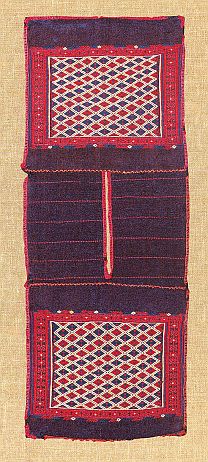
The front
designs can be elaborate.
And here is the full back of a different
one.
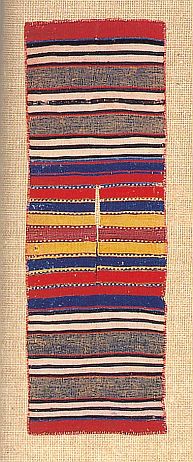
The backs
are usually colorfully striped and the nature and color of the striping can help
in attribution.
Some heybe’s are reinforced heavily with leather, as part
of their original construction, and that is the sort I bought.

Heybes are carried over
one’s shoulder.

Or over one’s arm.

But the long connecting section is
likely intended to permit a heybe to be placed behind a horse's
saddle.

The
backs are plain woven, but the more elaborately patterned front panels can be
either flatweave or pile. Pile Turkish bags are rather rare.
I ran into
one heybe face in pile at a local flea market last year, without knowing what it
was.
Here is a link to the conversation we had about it:
http://turkotek.com/misc_00029/Balouch%20Yomut%20What.htm
In
this conversation, Lars Jurrell, who follows this format a bit, had interesting
things to say and Ali Tuna put us onto the only book to date on the heybe
format.
It is “Traditional Saddlebags from Anatolia,” by Bieber,
Pinkwart and Steiner (the latter two wrote the only book on the grain sacks from
this same area of northwest Turkey).

The pieces in this book are
stunning and one wonders how they managed to find so many high quality instances
of a format that one hardly ever encounters on the U.S. market.
With that
background, perhaps I should show you my humble piece.
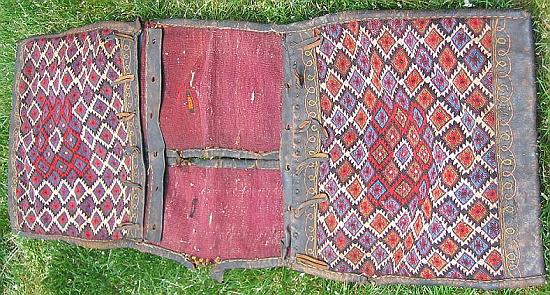
It is flatwoven front and back with
a compartmented design that I like and has a nice use of blue, wine, black and
white.
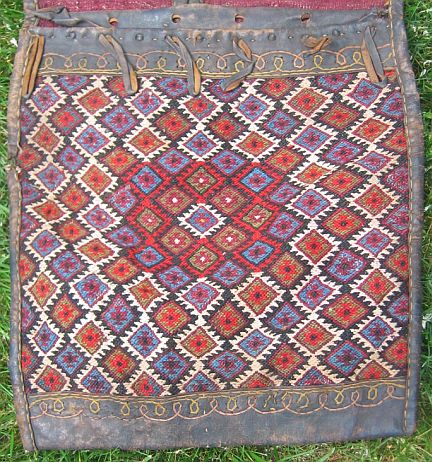
I also
liked the fact that the closure system was largely intact.
I worried about
the red (and still do) as a likely synthetic. I liked the fact that it was
leather-bound and that the leather was in good shape and modestly
embossed.
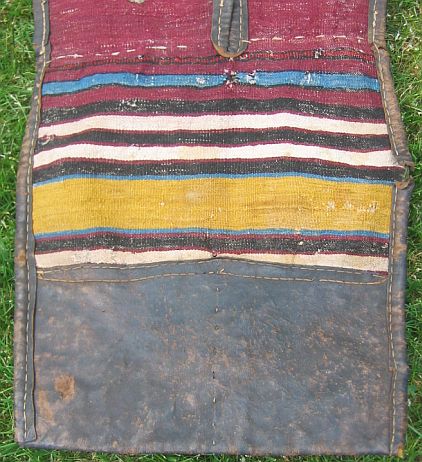
I
liked the striping on the back and the wine, blue, yellow, black, white
combination.
As I said in the discussion of the "sash," this heybe was
also attributed to Balikesir by an experienced Ottoman antiques dealer in
Selcuk.

I had
varying opinions as others saw it, as I went along, about whether the bright
bits on the connecting panels are original or added later. If original, this
makes the red of the piece even more suspicious.
One more thing about the
fact that this piece is leather-bound. One dealer downstream from Bergama was
excited about that. He said that if it were his he would carefully remove the
leather and we would then be able to see the currently covered areas as they
were when the piece came off the loom. (There may be something to this since you
can see in one small area in the image above there there is a two-color selvege
under the leather.)
An interesting notion.
As always, comments and
opinions are invited.
Regards,
R. John Howe
Posted by Lloyd Kannenberg on 05-24-2007 08:35 AM:
Hello John,
I like your heybe! The leather binding may not be original,
but I think it's attractive anyway.
The book "Sattel Taschen" by Helmut
Reinisch has about a dozen images of heybes, and the NERS online exhibit "To
Have and to Hold" also includes a couple, Plates 2 and 3.
Thanks for sharing
yours with us.
Lloyd Kannenberg
Posted by Marty Grove on 05-24-2007 08:50 AM:
Bags
G'day John and all,
Woven bags in all their forms, large and small,
have always appealed to me and those you show, including your new one, still
affect me nicely.
Myself, I throw a nice old bag behind me on my
motorcycle with all my stuff daily, on my way to work. When not using the bike
and Im off to the shop I throw it over my arm as do those in your photos
above.
I do get a few funny looks, but dont really mind as the bag is
beautiful with great colours and is so practical nowadays, we being assaulted
from all sides, in efforts to get us to assist against global warming by not
using plastic shopping bags.
My large bags are really useful for storing
clothes and jumpers etc when travelling out bush, except they tend to pick up
burrs, twigs and other ground stuff when thrown around carelessly.
I have
always thought it a pity that oriental woven bags have never become an 'item',
fashionable for general use in the West - we dont have anything so functional
really, except those soft, big leather bags from high end companies which tend
to charge the earth for them, not really accessable for normal
purchasers.
Regards,
Marty.
Posted by Steve Price on 05-24-2007 09:06 AM:
Hi Marty
Luggage made from pieces of rugs and bags had quite a run in
the USA in the 19th century. At the end of the War of Northern Aggression, the
(damn) Yankees who migrated into the former CSA to enjoy the spoils of war
became known as carpetbaggers, a term that still means "unwelcome exploiters
from elsewhere" in much of this country.
Regards
Steve Price
Posted by R. John Howe on 05-24-2007 10:07 AM:
Lloyd -
Are you seeing something that suggests to you that the leather
on my piece may not be original?
I asked about leather-bound pieces
before, and the answer was that they were usually made that way to begin with,
not as an effort to prolong use once a piece was somewhat worn (although I
suspect that could have been done and sometimes was).
Maybe Lars or Ali
will see this and comment on that point.
You may have, inadvertently,
given me an additional reason for removing the leather. To see if the covered
area is worn or pristine. 
Regards,
R. John Howe
Posted by Lloyd Kannenberg on 05-24-2007 10:39 AM:
Hi John -
I, too, always thught the leather bindings were original, but
it seems a shame to cover up that cool selvage!
It might be worthwhile to
open up a little of the binding to see what's underneath, but I would be very
reluctant to remove the leather altogether. Whatever you do, I hope you make
sure the procedure can be reversed.
Good luck!
Lloyd Kannenberg
Posted by Patrick Weiler on 05-24-2007 08:46 PM:
Is that a banana in that bag?
John,
You don't say if your new acquisition is large enough to carry a
couple of bottles of Laphroaig back from the liquor store.

I am curious how big it is and if
these heybes come in various sizes similar to the Persian and Caucasian
versions, or if they are all the same size.
On our trip to Turkey for the
ICOC, we started in Athens for a few days (until our luggage caught up with us)
and then took a ferry to the west coast of Turkey, driving up the coast and
stopping to view the ruins in Ephesus, Bergama and Troy. I, too, passed the same
rug stores you encountered, with their pieces hung outside. For anyone
interested in nice, antique oriental rugs (that would probably be most of us) I
do not recommend Greece. There are some nice embroideries, but the rugs in the
few shops I ventured into seemed to have gotten their stock from the same
warehouse.
But, back to Bergama. The town itself works its way up a hill,
with the Pergamon ruins at the top.
http://en.wikipedia.org/wiki/Pergamon
The closer you get to
the Acropolis at the top of the hill, the more compact, dense and crowded the
town is, with a maze of delightful narrow, winding streets and shops. We were in
a bit of a hurry, so I did not have a chance to visit the rug stores, though,
knowing that you would be hot on our trail and would appreciate it if we left
some goods behind for you to encounter.
I notice that the closures are
leather strips, so one would assume that the bag was initially made with the
leather sewn on. The leather was probably meant to lessen the number of
Australian burrs the heybe would pick up when handled carelessly.
Patrick
Weiler
Posted by R. John Howe on 05-25-2007 07:50 AM:
Hi Pat -
We are grateful that you left a few things in Bergama for us
to glean.
About variation in heybe size: there is some. I'm leafing
through the book and lengths seem to vary between 102 and 154 cm, while widths
are from about 29 to 60 cm. Those are pretty big differences.
Yes, we
could do a salon on narrow, crooked streets in Turkey if we could find a way to
relate it to rugs. 
Regards,
R. John Howe
Posted by Marty Grove on 05-25-2007 08:50 AM:
G'day all,
Thanks Steve, my ears always pricked when I heard the word
'carpetbag' or read it, and presumed they were manufactured using machine woven
materials even though I always rather hoped they were 'real'. 
And Im sure that when the
carpetbaggers were ducking and weaving in their attempts to escape the flaming
arrows in the dry and dusty Wild West, Patrick, their bags were just as
thoroughly invaded by spiked vegetation ... 
Regards,
Marty.
Posted by R. John Howe on 05-25-2007 10:29 AM:
NERS Heybe Examples
Dear folks -
As mentioned in the "grain bag" thread, one of the New
England Rug Society's on-line exhibitions treats a variety of bags.
Bags
2 and 3 are examples of heybes.
Link to bag 2:
http://www.ne-rugsociety.org/gallery/bags/bags-navframe.htm
Note
that bag 2 is a rarer pile example.
Link to bag 3:
http://www.ne-rugsociety.org/gallery/bags/bags-navframe.htm
Bag
3 is very small and speaks to the question of how small heybes sometimes
were.
Regards,
R. John Howe
Posted by Lars_Jurell on 05-25-2007 12:32 PM:
Hello all
I had a close look at my two saddle bags with leather, one from
Bergama area, one from Sivas area in Anatolia.
Both seems to have the leather
from the beginning.
And both with bindings of leather.
Bindings is not
common on Anatolian heybes ( bags ).
But I think the weaver was weaving
the bag as normal, then after it was finished the leather was put on.
So
I am sure the leather on the bag in this thread is original.
Another bag
with leather can you see in the thread on "Show and Tell" about weaving from
Savak Kurds.
The leather on that bag is also
original.
Regards
Lars Jurell
Akrep oriental Rug Society,
Sweden
Posted by Lars_Jurell on 05-27-2007 01:18 PM:
John and all
I asked a member in our rug society, Sonny Berntsson who
is very familiar with Anatolia and their textiles, about traditions with leather
on heybes.
First he told that John´s heybe with diamonds, said as a
Balikesir heybe, is from Dösemealti area, the mountains around Elmali and
Fethiye, SW Anatolia.
The people both in Bergama area and Dösemealti area are
Turkmens, related to each other.
Many textiles, sold as Bergama, are from
Dösemealti.
Traditions with leather on heybe´s are most common in West
Anatolia.
And the leather is changed many times during the heybe´s life,
depending on that it is destroyed and not taken care of.
The owner goes to a
“saddle-maker” ( Swedish in English ) who change the leather. This can happened
each 5-10 years.
Regards
Lars Jurell
Akrep Oriental Rug Society,
Sweden
Posted by R. John Howe on 05-27-2007 02:29 PM:
Dear Lars -
Thanks to both you and Sonny for these additional
indications.
Interesting stuff.
Sounds like I could remove the
leather, if I want, without intruding on the "soul" of this piece. 
Regards,
R. John Howe
Posted by Lars_Jurell on 05-27-2007 02:42 PM:
That is up to you.
But take some photos first for the future.
On my
textiles I don´t remove leather, "tribal" reparations or anything else that is a
part of the history.
Lars Jurell












